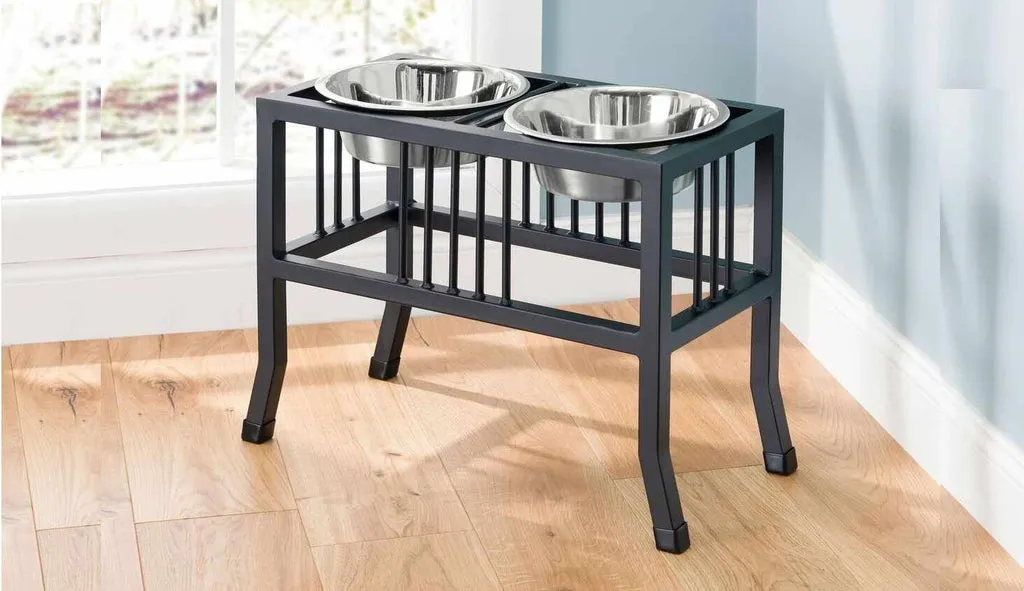Large dog breeds bring immense joy and companionship into our lives, but they also have unique needs, especially when it comes to mealtime. Ensuring your majestic canine friend eats comfortably and healthily is paramount for their well-being. An elevated dog feeder for large dogs can be a game-changer, providing an ergonomic solution that supports better posture, digestion, and overall mealtime enjoyment. This isn’t just about convenience; it’s about optimizing your large dog’s health and comfort with every bite and sip.
Why Elevated Feeders Are Essential for Large Breeds
For breeds like German Shepherds, Great Danes, Labradors, and Mastiffs, reaching down to a bowl on the floor can put unnecessary strain on their necks, backs, and joints. This awkward posture, repeated multiple times a day, can contribute to discomfort over time, especially in older dogs or those prone to conditions like arthritis. Elevated dog feeders mitigate this issue by bringing the food and water to a more natural height, allowing your dog to eat and drink in a relaxed, upright position. This ergonomic design promotes better spinal alignment and reduces the physical stress associated with mealtime.
Furthermore, some veterinarians suggest that elevated bowls can aid in digestion by allowing food to travel more smoothly to the stomach. While the link between elevated feeders and the prevention of bloat (gastric dilatation-volvulus or GDV) is still debated and not definitively proven, many owners report that their dogs experience less gas and discomfort when using raised bowls. Keeping the feeding area cleaner is another significant benefit, as less bending means less mess from spills and splashes, particularly for enthusiastic eaters or those with long ears.
Key Features to Look for in a Premium Elevated Dog Feeder
When investing in an elevated feeder for your large dog, quality and functionality are paramount. Look for designs that prioritize your dog’s comfort and your home’s aesthetics. Premium options offer a blend of thoughtful engineering and durable materials designed to withstand the rigors of large dog ownership.
Uncompromising Stability and Durability
A high-quality elevated feeder should feature furniture-grade craftsmanship, ensuring it remains sturdy and stable, even with the most energetic eaters. Look for single-piece construction or robust, well-assembled designs that prevent wobbling or tipping. Materials like 304 stainless steel, elegant wrought iron, or solid wood not only offer exceptional durability but also add a touch of sophistication to your home decor. These materials are built to last, making them a worthwhile investment for your dog’s long-term health.
 An elegant black elevated dog bowl stand with two stainless steel bowls, designed for large breeds.
An elegant black elevated dog bowl stand with two stainless steel bowls, designed for large breeds.
Designed for Health and Hygiene
Easy cleaning is a non-negotiable feature for any dog feeder. Opt for sets with removable, dishwasher-safe stainless steel bowls, which are hygienic and effortless to maintain. Many quality feeders incorporate rubber rims on the bowls to prevent clanking noises during mealtime, offering a quieter and more pleasant dining experience for your dog. Additionally, non-slip features like rubber tips on the feet are crucial to prevent the feeder from sliding across the floor, especially on smooth surfaces. A generous bowl capacity, typically 12 cups (3 quarts) or more, helps minimize spills, catering even to the most enthusiastic drinkers and eaters. For those considering multiple pets or a comprehensive setup, a 3 bowl raised dog feeder or a 3 bowl elevated dog feeder might also be an excellent option for managing food and water needs efficiently.
Choosing the Right Height and Style for Your Canine Companion
The correct height is crucial for an elevated feeder to provide its ergonomic benefits. To determine the ideal height, measure your dog from the floor to the top of their shoulder (or elbow). The top of the bowl should be roughly at your dog’s chest height or slightly below, allowing them to eat without bending their neck excessively or having to stretch upwards.
Common height ranges include:
- 12″ – 15″ Stands: Ideal for large breeds such as Boxers, Dalmatians, Labrador Retrievers, Golden Retrievers, German Shepherds, Siberian Huskies, and Standard Poodles.
- 18″ – 24″ Stands: Perfect for extra-large and giant breeds like Akitas, Great Danes, Bernese Mountain Dogs, Irish Wolfhounds, Mastiffs, Saint Bernards, and Newfoundlands.
Beyond height, consider the aesthetic appeal. Modern elevated dog feeders are designed to blend seamlessly with contemporary home decor, featuring chic designs and finishes that enhance your living space. Additionally, explore optional features such as slow-feed bowls, which are excellent for dogs who eat too quickly, helping to improve digestion and reduce the risk of choking.
Conclusion
Choosing the right elevated dog feeder for your large breed is an important decision that impacts their daily comfort and long-term health. By prioritizing ergonomic design, durable materials, and easy maintenance, you provide your beloved companion with a superior dining experience. A well-chosen elevated feeder not only supports their physical well-being but also enhances the cleanliness and style of your home. Investing in a quality feeding station is a testament to your commitment to their health and happiness. Discover more high-quality products and tips for your furry friends on the best website to buy dog supplies to ensure you’re always making the best choices for your pet.
